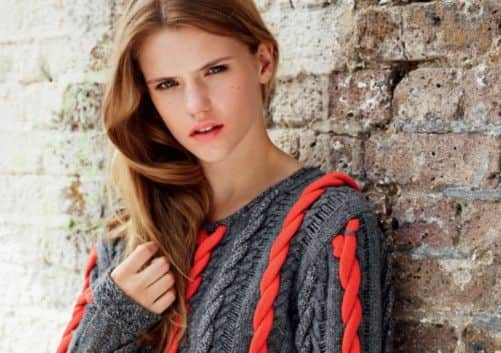Fashion: Scottish students show shear quality


SHEEP are as much a part of the Scottish landscape as heather, mist-clad Munros and mythical monsters, so it’s no surprise that, when it comes to wool, we do particularly well.
Our knitwear is acknowledged as among the best in the world, with designers including Christopher Kane, Mulberry, Burberry, Gucci, Hermes and Prada flocking to have their garments made here. And Chanel’s purchase of the Barrie mill in Hawick a year ago merely affirmed what the rest of the industry already knew. Scottish wool is in the midst of a serious revival.
Advertisement
Hide Ad“There have been tremendously difficult times for all textile manufacturing – from the spinning process right through to garment manufacturing – over the past few decades,” says Sheila-Mary Carruthers, an honorary professor at Heriot-Watt University and a part-time lecturer and design consultant. “However, luckily, it has survived. Not in the same form and not to the same extent, but it is now flourishing simply because, in recessionary times, you look at things more carefully. If you’re going to make a purchase, you want to make it a worthwhile purchase, you want it to have integrity; to have visual style but also some lasting quality. Scotland in particular has produced superb product, and wool, being a long-lasting fibre, has been the basis of all that.”


As a recognition and celebration of this resurgence, the Campaign for Wool’s Wool School this year presented three Scottish students with the opportunity to work with three Scottish brands, producing a jumper with the theme “knitwear traditions of the British isles”. The winning designs will be sold in stores throughout Wool Week (14-20 October).
But what emerged over and above the participation of Scottish universities and labels was a wider love of our nation’s yarn. A UK-wide competition, there are 15 winning Wool School designs in total, featuring brands such as Topshop, Barbour and Christopher Raeburn for Harvey Nichols.
Lyle & Scott, which teamed up with Central Saint Martins, has been manufacturing in Hawick since 1874 and has seen its Scottish wool output increase by five per cent. As this year’s competition coincides with the firm’s 140th anniversary, the student’s design includes a newly registered Lyle & Scott tartan.
Margaret Howell worked with Scottish knitwear brand Eribe to create her chosen jumper, designed by a University of Brighton student, saying she preferred the irregularity of the traditional technique to a machine finish.
And Marks & Spencer, which worked with the University of Leeds, made its jumper in Hawick, as part of its upcoming Best of British collection that recognises British craftsmanship and quality.
Advertisement
Hide Ad“A sheep’s fleece comes with a lot of impurities,” explains Carruthers, who is based in Melrose and has 43 years of experience in the textiles industry. “All that has to be removed, and one of the strengths in Scotland is the finishing, and the fact we have good water. The physical washing and drying is a process that is highly skilled and we do it very well.
“Scotland has always what we call ‘under-finished’ our cashmere,” she adds. “In Italy they live in the moment, they like their cashmere to feel immediately soft and luxurious. In Scotland you will get a cashmere garment that, actually, the more you wash it, the better it handles. It’s designed on a slow burn of finishing so that it will last you longer and it won’t pill as much. That’s what makes our cashmere special.”
Advertisement
Hide AdSo, while a revival is good news for the industry, it’s also good news for the consumer. “They get a product that’s extremely well made,” says Carruthers. “In addition they will be secure in the knowledge that the worker is being paid a living wage and the conditions under which people are working are good and healthy and they’re contributing to the UK economy.” n
Lindsay McQuarrie
University Duncan of Jordanstone, Dundee
Design partner: Brora
Paisley-born McQuarrie’s horizontal stripe, brushed yarn, Shetland wool design that incorporates elements of mohair was chosen by Brora’s founder Victoria Stapleton for its “earthy colours and tangy shades – being really reflective of Scottish heritage, and there’s a great contemporary feel.
“At Brora we are obviously very keen on all things woolly,” she adds. “The business started 20 years ago with the aim of working with the very best Scottish textile mills, primarily working with cashmere and Shetland yarns, and today we still work very closely with some extraordinary craftspeople. It is terribly important to keep supporting this industry as so many retailers have moved abroad with their manufacture, chasing bigger margins. Our first motivation is to support traditional woollen mills in the British isles.”
Francesca Stride
University Glasgow
Design partner: Pringle of Scotland
Stride, originally from Marchmont in Edinburgh, designed a boat-neck, fine-knit Scottish lambswool sweater that was washed in the waters of the Teviot to create the soft feel. It features a complicated reverse intarsia, an updated interpretation of the Argyle pattern, and will be added to the label’s archive in Hawick, which displays 100 years of its knitwear.
Stride says: “The starting point for Pringle’s brief was the brand’s signature diamond pattern, Argyle. I took photographs of anything around me that reminded me of the pattern – architectural details like drain covers, railings, unusual windowpanes and tiles.”
Katy Wallace, from Pringle’s design studio, says: “Francesca’s entry gives us the biggest technical challenge, but the outcome of the graphic is really strong. It’s nice for us to be challenged.
Advertisement
Hide Ad“There are the obvious attractions to wool as a natural fibre, including its comfort and warmth, but its versatility and the scope for constantly discovering new ways of working with wool is what makes it so special. We are always exploring new knitwear techniques; the possibilities are endless.”
Emma Lawrie
University Edinburgh
Design partner: Folk
London-based fashion label Folk, headed by Scot Cathal McAteer, wanted to take part in the project “primarily because wool is such an important natural fibre and the possibilities when working with students are so vast as they are in such a creative environment without too much knowledge of manufacturing constraints”.
Advertisement
Hide AdLawrie adds: “My inspiration stemmed from the fishing heritage of Aberdeen and Aberdeenshire. I was inspired by the traditional gansey and cable knits created for fisherman and netting woven by fishwives. I wanted to modernise and add my own twist.”
McAteer was not deterred by the challenge the design presented. “We would rather pick the most stunning garment then work on how to manufacture it as closely as possible to the original idea. Often this is the part that can have unexpected but often pleasing outcomes.”
He adds: “It’s important to use materials that will last and keep their beauty as they age. Wool is one of these materials.”
• Wool Week, 14-20 October, www.campaignforwool.org
All jumper designs will be available in Scottish stores and online (www.brora.co.uk; www.folkclothing.com; www.pringlescotland.com)